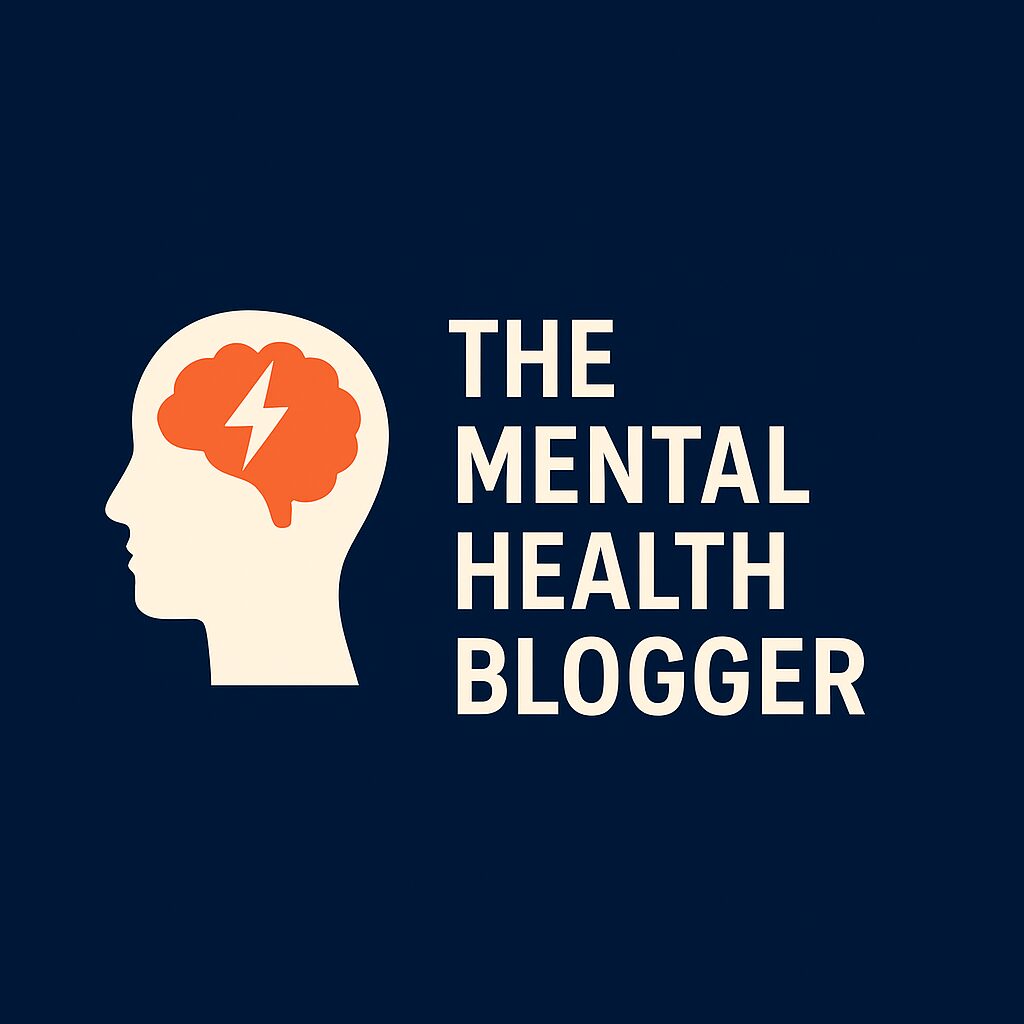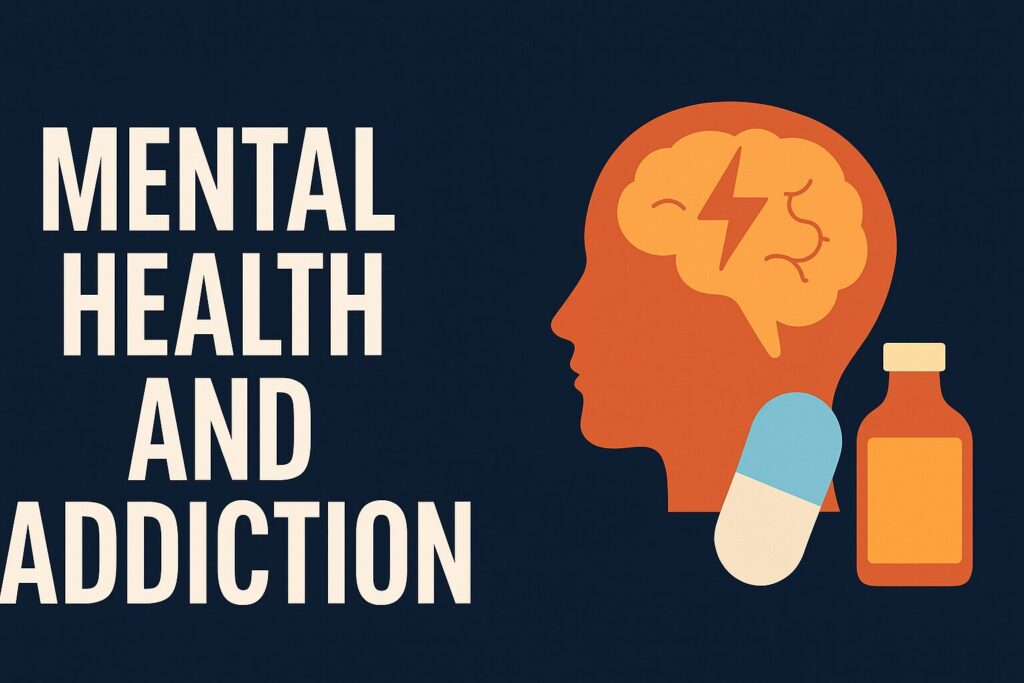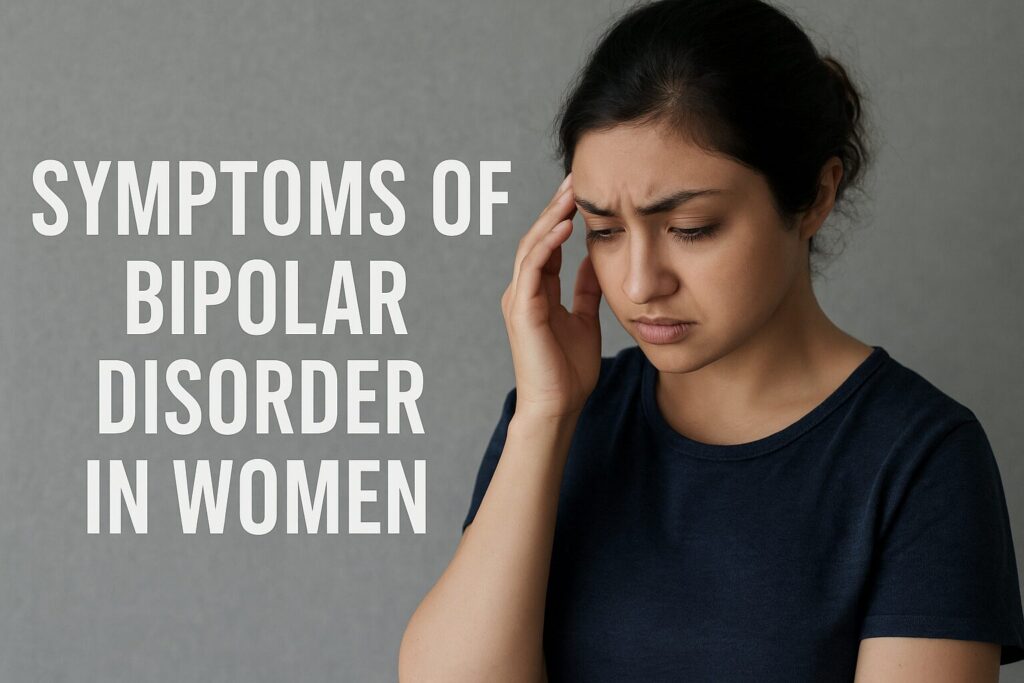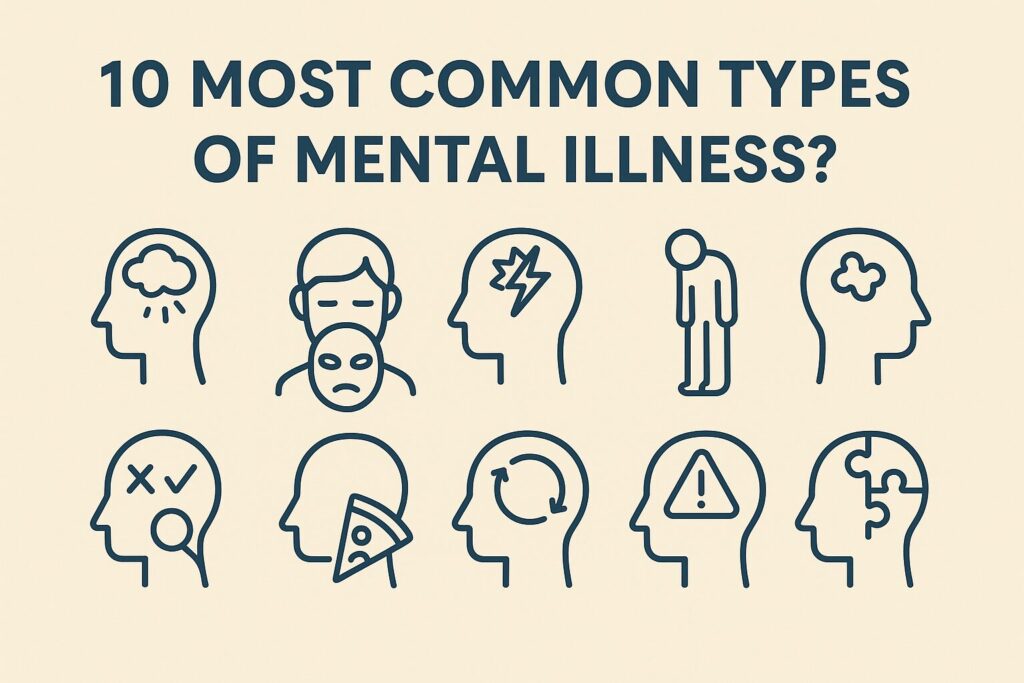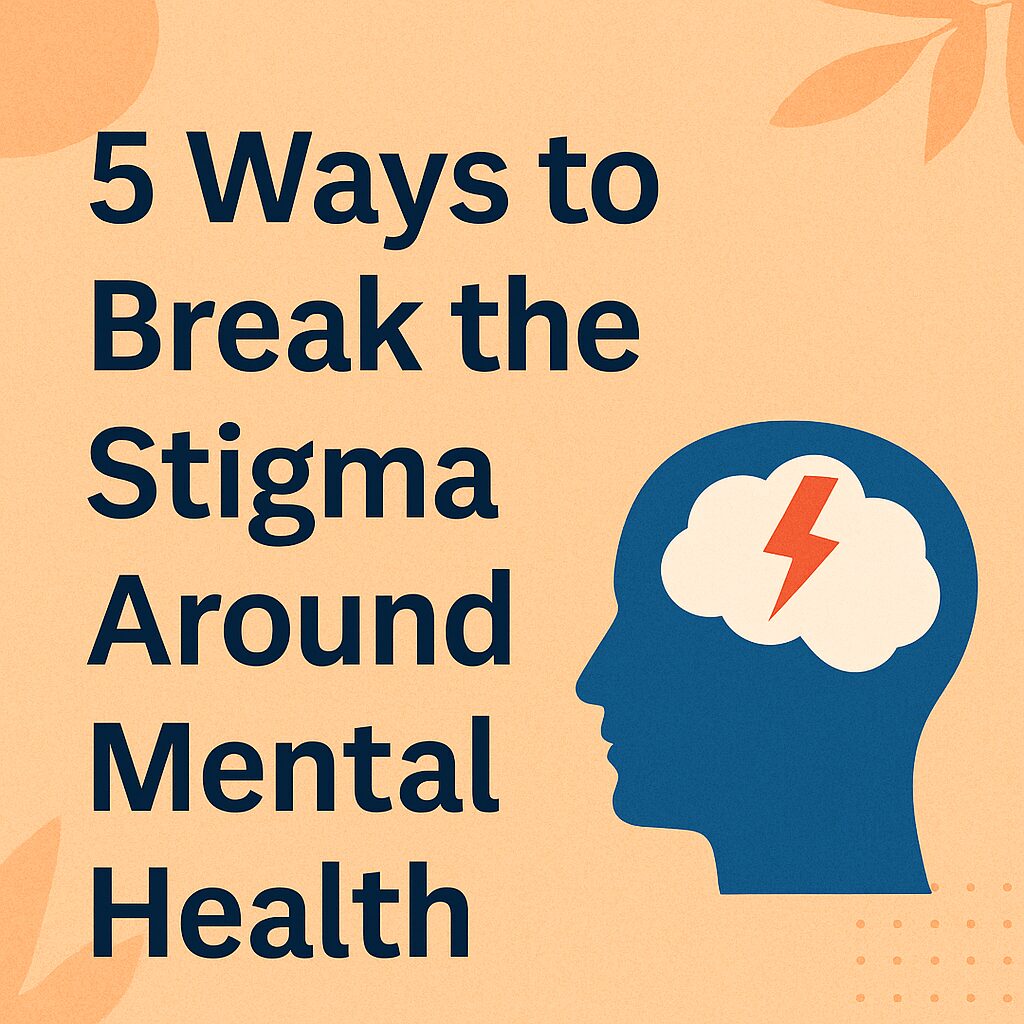
Contents
- 1 Introduction: Breaking the Stigma Around Mental Health
- 2 5 Ways to Break the Stigma Around Mental Health
- 3 1. Start Honest Conversations About Mental Health
- 4 2. Educate Yourself and Others
- 5 3. Challenge Negative Stereotypes
- 6 4. Promote a Supportive Community Environment
- 7 5. Lead by Example
- 8 Conclusion: Creating a World of Acceptance
- 9 Final Thoughts
- 10 FAQ: Breaking the Stigma Around Mental Health
- 11 References
Introduction: Breaking the Stigma Around Mental Health
Discover five powerful ways to break the stigma around mental health. Learn how open conversations, education, empathy, and community support can create lasting change and encourage people to seek help without fear or shame.
Why Breaking the Stigma Matters
For many people, talking about mental health still feels uncomfortable.
Society has made huge strides in understanding emotional wellness, but stigma continues to hold many back.
Too often, individuals struggling with anxiety, depression, or other mental health challenges stay silent out of fear. They fear judgment, misunderstanding, or being seen as weak.
Breaking the stigma around mental health means replacing that fear with understanding.
It means creating a world where conversations about mental health are just as normal as talking about physical health.
When we openly discuss topics like therapy, emotional struggles, and recovery, we show others that it is okay to seek help.
We remind people that healing begins with honesty.
Using empathy and awareness, every person can play a role in reducing stigma.
Whether through small conversations or large community efforts, you can help make a difference.
Understanding the Mental Health Stigma
The stigma surrounding mental health comes from generations of misinformation and fear.
For centuries, mental illness was misunderstood and often ignored. People were labeled, shamed, or excluded instead of being supported.
This deep-rooted misunderstanding has made many afraid to seek help or admit when they are struggling.
Today, the stigma takes many forms. It might appear as a joke about therapy, a dismissive comment about anxiety, or even silence when someone opens up.
These actions send the message that mental health is something to hide. By recognizing how stigma still appears in daily life, we can begin to change it.
Breaking the stigma around mental health starts with awareness.
It begins when we choose to listen, to learn, and to respond with compassion rather than judgment.
The Power of Open Conversations
Talking about mental health can be uncomfortable at first, but it is one of the most powerful ways to create change.
Open conversations normalize the topic and make others feel safe to share.
When you talk about your own experiences or simply listen without judgment, you help build trust.
Every honest conversation is a step toward breaking barriers. When mental health becomes part of everyday dialogue, it helps others realize they are not alone.
Families, friends, schools, and workplaces all benefit from these discussions. It creates an environment where seeking help feels natural, not shameful.
By speaking openly, you make mental health a part of normal life. This is how stigma begins to lose its power.
The Role of Education in Reducing Stigma
Education is another key to ending stigma. When people understand what mental health really means, fear and prejudice begin to fade.
Schools, media, and communities that teach accurate information about mental illness help create acceptance.
Learning that conditions like depression or anxiety are common and treatable changes how people think.
It replaces judgment with empathy. Education encourages compassion and builds stronger, more supportive communities.
The more people learn, the less they fear. Knowledge has the power to open minds and hearts, paving the way for a society where mental wellness is valued and respected.
Building a Supportive Community
Breaking the stigma around mental health is not just an individual effort. It takes a community.
A supportive community encourages open dialogue, provides resources, and stands together to help those in need.
Community support might mean creating local awareness campaigns, organizing mental health events, or simply checking in on friends and neighbors.
It can also mean supporting mental health initiatives at work or in schools.
When communities unite to promote understanding and compassion, stigma loses its foundation.
Together, people can create spaces where everyone feels accepted and valued, no matter what they are going through.
What does it mean to break the stigma around mental health?
Answer: Breaking the stigma around mental health means changing negative attitudes and misconceptions about mental illness. It involves promoting understanding, compassion, and open communication so that people feel safe discussing their mental health without fear of judgment.
5 Ways to Break the Stigma Around Mental Health
Why We Must Break the Stigma
For generations, mental health has been treated as a taboo subject. People were often told to “stay strong,” “snap out of it,” or “keep it to themselves.”
But mental health is just as important as physical health. When we avoid talking about it, we allow myths, fear, and shame to grow.
Breaking the stigma around mental health is not just about raising awareness. It is about changing the way society thinks, talks, and acts.
It is about compassion, education, and open communication. Each of us has the power to change how mental health is viewed.
With small actions and consistent effort, we can help create a world where everyone feels safe to seek help without judgment.
This guide explores five effective ways to break the stigma around mental health.
Each step is simple, practical, and powerful. Together, they can help shape a culture that values emotional well-being, support, and understanding.
1. Start Honest Conversations About Mental Health
Talk Openly and Without Fear
The first step to breaking the stigma around mental health is to talk about it. Honest conversations open the door to understanding.
When people share their experiences, it helps others realize they are not alone. You do not have to be an expert to talk about mental health. You just need to be open, kind, and willing to listen.
Sharing your story or listening to someone else’s can break barriers that silence has built for decades.
Talking about mental health reduces shame and encourages others to reach out for help.
It also helps normalize the topic in daily life, from homes and schools to workplaces and communities.
How to Start the Conversation
- Begin with empathy. Ask, “How are you really feeling today?”
- Listen without judgment. Avoid giving quick advice or dismissing their feelings.
- Share your own experiences to build connection and trust.
- Use positive, non-clinical language to make the conversation feel safe.
- Encourage professional help when needed, but always respect the person’s pace.
Each time you speak openly, you create a ripple of change. One honest conversation can inspire many others.
2. Educate Yourself and Others
Knowledge Breaks Fear
Education is a key part of breaking the stigma around mental health.
Misunderstanding fuels prejudice, but learning replaces it with compassion.
When people understand what mental illness truly is, they stop seeing it as weakness or something to hide.
Mental health education helps people recognize that conditions like depression, anxiety, bipolar disorder, and PTSD are medical conditions, not personal failures.
Just like diabetes or heart disease, mental health conditions require care, treatment, and understanding.
Ways to Educate Yourself and Your Community
- Read credible articles, books, or online resources about mental health.
- Attend mental health awareness events or workshops.
- Follow organizations like NAMI or Mental Health America for accurate information.
- Share educational posts on social media to help spread awareness.
- Encourage schools and workplaces to include mental health programs.
When we educate ourselves, we become advocates for change. Knowledge gives us the confidence to speak up and support others.
3. Challenge Negative Stereotypes
Recognize and Correct Harmful Beliefs
Many people still believe myths about mental illness. They may think that those struggling are “lazy,” “unstable,” or “overreacting.”
These beliefs are not only wrong but also deeply harmful. Challenging these stereotypes is essential for creating real change.
Breaking the stigma around mental health means speaking up when you hear hurtful comments or see discrimination.
Silence allows stigma to grow, but speaking up promotes truth and compassion.
How to Challenge Stigma in Everyday Life
- Politely correct false statements about mental health.
- Share facts when people spread myths or misinformation.
- Support and defend others who are being unfairly judged.
- Avoid using harmful language like “crazy” or “psycho.”
- Highlight stories of recovery and strength to inspire understanding.
Each time you challenge negativity, you replace it with truth. You help others see that mental health struggles are human experiences, not personal flaws.
4. Promote a Supportive Community Environment
What are some ways communities can help break the stigma around mental health?
Answer: Communities can help break the stigma around mental health by hosting awareness events, supporting mental health initiatives, and encouraging open dialogue. A united community sends a strong message that mental health matters to everyone.
Create Spaces of Understanding and Empathy
Communities play a huge role in shaping how mental health is viewed.
A supportive environment helps people feel safe to talk about their struggles. When friends, families, schools, and workplaces come together, stigma begins to fade.
A compassionate community values emotional health as much as physical health.
It recognizes that everyone faces challenges and that support should be available to all.
This type of culture can save lives by encouraging early intervention and open communication.
Ways to Build a Supportive Community
- Organize local awareness events and workshops.
- Share mental health resources in schools, offices, and public spaces.
- Encourage open discussions in group settings or online forums.
- Support mental health initiatives or volunteer for related organizations.
- Celebrate Mental Health Awareness Month and similar campaigns.
A community that supports mental wellness builds resilience. It creates belonging, connection, and safety. When people know they are not alone, they are more likely to reach out and heal.
5. Lead by Example
Show Others That It’s Okay to Care for Your Mental Health
The most powerful way to break the stigma around mental health is to lead by example.
People notice what you do more than what you say. When you prioritize your mental well-being, you show others that it is okay to do the same.
Taking care of your mind is a sign of strength, not weakness.
Whether you go to therapy, practice mindfulness, or simply take breaks when overwhelmed, your actions send a strong message.
They tell others that it is okay to seek help and care for themselves.
Practical Ways to Lead by Example
- Be open about going to therapy or using self-care practices.
- Speak kindly about yourself and others when discussing mental health.
- Encourage healthy habits like rest, exercise, and stress management.
- Support coworkers, friends, or family members who are struggling.
- Be patient with those who are not ready to talk.
Your actions can influence others to let go of fear and embrace self-care. Leadership through example makes change possible at every level.
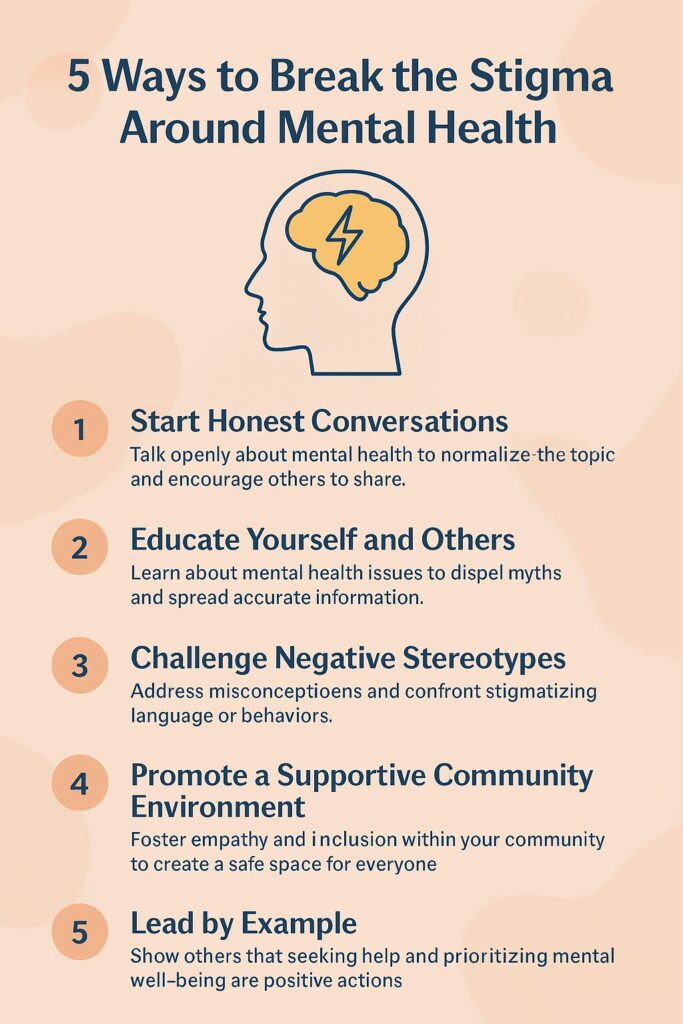
Conclusion: Creating a World of Acceptance
Breaking the stigma around mental health is not just a campaign or a trend. It is a lifelong commitment to compassion, education, and empathy.
Every small action matters. Talking openly, learning the facts, and supporting others can change how society views mental wellness.
When we replace silence with conversation and judgment with kindness, we create a safer, more understanding world.
A world where people feel encouraged to ask for help, to heal, and to grow.
You have the power to make that change.
Each conversation, each moment of empathy, each small act of support builds a future where mental health is respected and valued by all.
Let’s keep talking, keep learning, and keep helping each other.
Together, we can truly break the stigma around mental health.
Final Thoughts
The movement to end mental health stigma begins with us. It begins with kindness, honesty, and courage.
Every voice matters, every story matters, and every effort brings us closer to understanding.
Be the person who listens. Be the person who speaks up. Be the person who reminds others that seeking help is a sign of strength.
The more we normalize mental health care, the healthier and more compassionate our world becomes.
How We Can All Help Break the Stigma Around Mental Health
FAQ: Breaking the Stigma Around Mental Health
1. What does it mean to break the stigma around mental health?
Breaking the stigma around mental health means challenging the negative beliefs, stereotypes, and misconceptions that surround mental illness.
It involves changing how people think and talk about emotional well-being.
When we break the stigma, we create a culture of understanding and support where people feel comfortable seeking help without judgment.
It encourages open conversations, compassion, and equal treatment for mental and physical health concerns.
2. Why is it important to talk about mental health openly?
Talking about mental health openly helps normalize the topic. When people share their experiences, it reduces fear and shame.
Open dialogue also helps others feel less alone and more willing to seek help. Conversations lead to understanding, education, and acceptance.
They remind everyone that mental health challenges are part of the human experience and can be managed with care, treatment, and community support.
3. What are some common examples of mental health stigma?
Mental health stigma can appear in many ways, both subtle and direct. Common examples include:
- Judging someone for taking medication or going to therapy
- Making jokes about mental illness
- Avoiding people who are open about their struggles
- Using negative labels like “crazy” or “unstable”
- Dismissing emotional struggles as “attention-seeking” or “weakness”
Recognizing these behaviors is the first step toward stopping them. Awareness helps you choose more compassionate, respectful language and actions.
4. How can education help reduce the stigma surrounding mental health?
Education replaces misinformation with understanding. When people learn that mental health disorders are common, treatable, and not a personal failure, fear and prejudice start to fade.
Education helps communities build empathy, support, and acceptance. Schools, workplaces, and media outlets that teach accurate mental health information play an essential role in reducing stigma.
The more people understand mental wellness, the more supportive society becomes.
5. What can individuals do to help break the stigma around mental health?
Every person has the power to make a difference. Here are a few simple yet powerful ways to help:
- Speak openly about mental health when appropriate
- Offer support and listen without judgment
- Share educational resources and positive messages online
- Stand up against mental health discrimination
- Take care of your own mental wellness and lead by example
Each action, no matter how small, contributes to a larger movement of understanding and acceptance.
6. How can communities support mental health awareness?
Communities can host awareness events, share local mental health resources, and create safe spaces for discussion.
Schools can implement mental health education programs. Workplaces can promote wellness initiatives and provide access to employee support programs.
When a community promotes empathy and inclusion, it helps every member feel valued and supported. A united effort is one of the most effective ways to break mental health stigma.
7. How can language impact mental health stigma?
Words have power. The way we speak about mental health can either build understanding or reinforce stigma.
Using respectful and accurate language makes a huge difference. Avoid words that shame or belittle people.
Instead of saying “a schizophrenic,” say “a person living with schizophrenia.” Person-first language reminds us that people are not defined by their conditions. Small changes in how we speak can lead to big changes in how society thinks.
8. What role does social media play in reducing stigma?
Social media can be a powerful tool for spreading awareness.
When people share real stories, positive messages, and reliable information, they help normalize mental health discussions.
Online platforms can amplify voices that were once ignored.
However, social media can also spread misinformation, so it’s important to share accurate resources and engage with kindness.
The more people use these platforms for good, the more they help break stigma worldwide.
9. How can workplaces help employees feel comfortable discussing mental health?
Workplaces can promote openness by creating policies that support mental well-being.
This includes offering flexible schedules, providing access to counseling, and organizing mental health awareness days.
Managers should lead with empathy and model healthy work-life balance.
A culture of respect and understanding makes employees feel safe to discuss mental health issues and seek help when needed.
10. What are some myths about mental illness that should be corrected?
Here are a few of the most common myths:
- Myth: Mental illness is rare.
Fact: Millions of people experience mental health challenges every year. - Myth: People with mental illness are dangerous.
Fact: Most people with mental health conditions are not violent and are more likely to be victims than perpetrators. - Myth: You can “snap out of” depression or anxiety.
Fact: Mental health conditions require care, understanding, and treatment, just like physical illnesses.
Correcting these myths helps create a culture of truth and empathy.
11. What can parents do to teach children about mental health?
Parents can start by modeling healthy emotional habits. Encourage children to express their feelings and ask for help when needed.
Teach them that it’s okay to have bad days and that mental health is part of overall wellness.
Reading books about emotions, practicing mindfulness, and having open conversations all help children grow up without fear or shame surrounding mental health.
12. How does leading by example help break the stigma?
When you care for your mental health, others notice. Sharing your journey, whether through therapy, mindfulness, or simple self-care, helps normalize the idea that everyone deserves support.
Leading by example builds trust, encourages honesty, and shows others that seeking help is not a weakness but a strength.
People are more likely to follow when they see someone they respect practicing what they preach.
13. How can I support someone who is struggling with their mental health?
You do not need to have all the answers to help. Sometimes, the best support is simply being present.
Listen without judgment. Offer reassurance that it’s okay to ask for help. Encourage professional care if needed, but avoid pushing.
Simple acts like checking in, sending a message, or sharing resources can make a big difference. Compassion and patience can help someone feel seen and supported.
14. How can breaking the stigma improve society as a whole?
When stigma fades, people are more likely to seek help early, leading to faster recovery and better well-being.
Communities become more compassionate and inclusive. Workplaces become healthier and more productive.
Schools become more supportive environments for learning and growth.
Society as a whole becomes stronger, kinder, and more resilient when mental health is treated with the same importance as physical health.
15. What is the ultimate goal of breaking the stigma around mental health?
The goal is to create a world where mental health is understood, respected, and treated equally to physical health.
It is about ensuring everyone feels safe to talk, to heal, and to live without shame.
Breaking the stigma leads to stronger relationships, healthier communities, and a more compassionate world.
The change begins with each of us and continues through every honest conversation, act of kindness, and effort to understand.
References
- National Alliance on Mental Illness (NAMI)
Website: https://www.nami.org
Description: NAMI is one of the leading organizations dedicated to building better lives for people affected by mental illness. It offers educational resources, advocacy programs, and community support to help reduce stigma and improve mental health awareness. - Mental Health America (MHA)
Website: https://www.mhanational.org
Description: Mental Health America focuses on promoting mental health education, prevention, and early intervention. Their resources help individuals, families, and communities understand mental health conditions and work together to break stigma and encourage open conversations.
